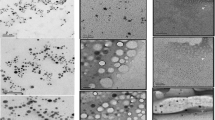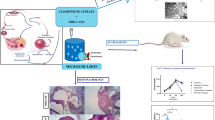Abstract
A high molecular weight water-soluble chitosan (WSC) with an average molecular weight of 300 kD and a deacethylation level of over 90% was produced using a simple multi-step membrane separation process. It is known that WSC prevents obesity induced by a high-fat diet. Consequently, this study investigated whether or not WSC improved the ovarian dysfunction caused by obesity in mice. The mice were fed a high density protein and lipid diet for 4 weeks, followed by the administration of WSC at 480 mg/kg body weight per day for 4 days. Thereafter, the changes in body weight, ovulation rate,in vivo andin vitro fertilization and embryonic development were measured. WSC markedly reduced the body weight of obese mice fed with a high-fat diet, but not in mice fed with a normal diet. WSC had significant effects on the ovulation rate, both thein vivo andin vitro fertilization rates and embryonic development. These results indicate an improvement in the ovarian and oviduct dysfunction caused by obesity, and suggest an adjustment in the internal secretions and metabolic functions.
Similar content being viewed by others
References
Bray, G. A., Obesity and reproduction. Hum. Reprod., 12 (suppl. 1), (1997).
Clark, A. M., Ledger, W., Galletly, C., Tomlinson, L., Blameu, F., Wang, X., and Norman, R. J., Weight loss results in significant improvement in pregnancy and ovulation rates in anovulatory obese women.Hum. Reprod., 10, 2705–2712 (1995).
Clark, A. M., Thomley, B., Tomlinson, L., Galletley, C., and Norman, R. J., Weight loss in obese infertile women results in improvement in reproductive outcome for all forms of fertility treatment.Hum. Reprod., 13, 1502–1505 (1998).
Dechaud, H., Ferron, G., Anahory, T., Arnal, F., Humeau, C., and Hedon, B., Obesity and assisted reproduction techniques.Contracept. Fertili. Sex., 26, 564–567 (1998).
Deuchi, K., Kanauchi, O., Imasato, Y., and Kobayashi, E., Effect of the viscosity or deacetylation degree of chitosan on fecal fat excreted from rats fed on a high-fat diet.Biosci. Biotech. Biochem., 59, 781–785 (1995).
Green, B. B., Weiss, N. S., and Daling, J. R., Risk of ovulatory infertility in relation to body weight.Fertil. Steril., 50, 721–726 (1988).
Grodstein, R., Goldman, M. B., and Cramer, D. M., Body mass index and ovulatory infertility.Epidemiology, 5, 247–250 (1994).
Han, L. K., Kimura, Y., and Okuda, H., Reduction in fat storage during chitin-chitosan treatment in mice fed a high-fat diet.Int. J. Obes., 23, 174–179 (1999).
Hill, J. O., Lin, D., Yakubu, R., and Peters, J. C., Development of dietary obesity in rats: influence of amount and composition of dietary fat.Int. J. Obes., 16, 321–333 (1992).
Illum, L., Chitosan and its use as a pharmaceutical excipient.Pharm. Res., 15, 1326–1331 (1998).
Kim, D. H., Lee, C., Kim, K. O., and Lee, Y C, Physicochemical and sensory properties of water soluble chitosan.Kor. J. Food. Sci. Technol., 31, 83–90 (1999).
Kumar, G., Smith, R J., and Payne, G. F., Enzymatic graftion of anatural product onto chitosan to confer water solubility under basic conditions.Biotechnol. Bioeng., 63, 154–165 (1999).
Lemonnier, D., Effect of age, sex and site on the cellularity of the adipose tissue in mice and rats rendered obese by a high-fat diet.J. Clin. Invest., 51, 2907–2915 (1972).
Norman, R. and Clark, A. M., Obesity and reproductive disorders: a review.Reprod. Fertil., 10, 55–63 (1998).
Muzzarelli, R. A., Clinical and biochemical evaluation of chitosan for hypercholesterolemia and overweight control. EXC, 87, 293–304 (1999).
Obst, B. E., Schemmel, R. A., Czajka-Narins, D., and Merkel, R., Adipocyte size and munber in dietary obesity resistant and susceptible rats.Am. J. Physiol., 240 (Endocrinol Metab 3), 47–53 (1981).
Oh, S. H., Miyoshi, K., and Funahashi, H., Rat oocytes fertilized in modified rat 1-cell embryo culture medium containing a high sodium cholride concentration and bovine serum albumin maintain developmental ability to the blastocyst stage.Biol. Reprod., 59, 884–889 (1998).
Pasquali, R., Casimirri, F., and Vicennati, V., Weight control and its beneficial effect on fertility in women with obesity and polycystic ovary syndrome.Hum. Reprod., (Suppl. 1), 82–87 (1997).
Peter, R., Ritsa, S., Per, O. D., Tom, T., and Thomas, A., Obesity is a risk factor for early pregnancy loss after IVF or ICSI.Acia. Obstet. Gynecol. Scand., 29, 43–48 (2000).
Ross, S. R., Reed, A. G., and Bruce, M. S., Targeted expression of a toxin gene to adipose tissue: transgenic mice resistant to obesity.Gene & Development, 7, 1318–1324 (1993).
Shepherd, R., Reader, S., and Falshaw, A., Chitosan functional properties.Glycoconj. J., 14, 535–542 (1997).
Summers, M. C., McGinnis, L. K., Lawitts, J. A., Raffin, M., and Biggers, J. D., IVF of mouse ova in a simplex optimized medium supplemented with amino acids.Hum. Reprod., 15, 1791–1801 (2000).
Toyoda, Y and Chang, M. C., Fertilization of rat egg.in vitro by epididymal spermatozoa and the development of eggs following transfer.J. Reprod. Fertil., 36, 9–22 (1974).
Wass, P., Waldenstrom, U., and Rossner, S., An android body fat distribution in females impairs the pregnancy rate of invitro fertilization-embryo transfer.Hum. Reprod., 12, 2057–2060 (1997).
Zaadstra, B. M., Seidell, J. C., Van Noord, P. A., te Velde, E. R., Habbemn, J. D., and Vrieswijk, B., Fat and female fecundity: prospective study of effect of body fat distribution on conception rates.Brit. Med. J., 306, 484–487 (1993).
Author information
Authors and Affiliations
Corresponding author
Rights and permissions
About this article
Cite this article
Choi, H.G., Kim, J.K., Kwak, D.H. et al. Effects of high molecular weight water-soluble chitosan on in vitro fertilization and ovulation in mice fed a high-fat diet. Arch Pharm Res 25, 178–183 (2002). https://doi.org/10.1007/BF02976560
Received:
Issue Date:
DOI: https://doi.org/10.1007/BF02976560




